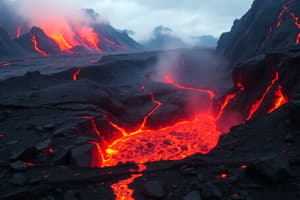Podcast
Questions and Answers
What distinguishes shield volcanoes from other types of volcanoes?
What distinguishes shield volcanoes from other types of volcanoes?
- Their symmetrical cones
- Their broad, gently sloping formations (correct)
- Their high elevation
- Their frequent explosive eruptions
Which type of magma is typically associated with shield volcanoes?
Which type of magma is typically associated with shield volcanoes?
- Rhyolitic magma with high silica content
- Basaltic magma with low silica content (correct)
- Andesitic magma with moderate silica content
- Obsidian magma with high viscosity
What is a common characteristic of shield volcano summits?
What is a common characteristic of shield volcano summits?
- Steep-sided slopes
- Frequent explosive eruptions
- Flat tops (correct)
- Deep valleys at the top
How wide can shield volcanoes span?
How wide can shield volcanoes span?
What kind of shield volcano is described as 'low shield volcano'?
What kind of shield volcano is described as 'low shield volcano'?
What distinguishes shield volcanoes from stratovolcanoes in terms of height?
What distinguishes shield volcanoes from stratovolcanoes in terms of height?
What is the average height of shield volcanoes?
What is the average height of shield volcanoes?
Which type of magma primarily feeds shield volcanoes?
Which type of magma primarily feeds shield volcanoes?
What is the typical width range of shield volcanoes?
What is the typical width range of shield volcanoes?
Which characteristic is a result of the low viscosity of basaltic lava in shield volcanoes?
Which characteristic is a result of the low viscosity of basaltic lava in shield volcanoes?
What type of lava flows are produced by basaltic magma in shield volcanoes?
What type of lava flows are produced by basaltic magma in shield volcanoes?
What is the silica content of basaltic magma that feeds shield volcanoes?
What is the silica content of basaltic magma that feeds shield volcanoes?
Flashcards are hidden until you start studying
Study Notes
Shield Volcanoes: Giant Landforms and Their Geological Signatures
Shield volcanoes are distinct, sprawling structures that cover vast swaths of Earth's surface, particularly in regions like Alaska, Iceland, and Alaska Peninsula. These volcanoes differ from their more familiar, conical brethren in several key characteristics, which we will explore in this article.
Geological Characteristics
Shield volcanoes are broad, gently sloping formations that often appear like domes or shields when viewed from a distance. Their dimensions are immense: they can range from 20-40 kilometers in width and extend for over 100 kilometers in length. Shield volcanoes are generally composed of basaltic lava flows, which accumulate gradually over a long period, resulting in their distinctive, sloping profile.
Description of Shield Volcanoes
Unlike the steep-sided, symmetrical cones of stratovolcanoes, shield volcanoes are characterized by their low elevation and relatively gentle slopes. They may reach elevations of up to 3,000 meters, but their tops are frequently flat, and their bases are often indented by valleys and craters. Shield volcanoes are also sometimes referred to as "dome volcanoes" or "low shield volcanoes" when their height is less than 1,000 meters.
Height and Wide
As mentioned, shield volcanoes typically do not reach the lofty heights of their more famous counterparts. Their average height is approximately 1,000 meters, and their width can exceed 40 kilometers, making them some of the largest volcanic features on Earth.
Magma in Shield Volcanoes
Shield volcanoes are primarily fed by basaltic magma, which is rich in silica content (50-54%) and has low viscosity (comparatively fluid) and low gas content. The relatively low viscosity of basaltic lava means that it flows easily, resulting in the characteristic smooth and gentle slopes of shield volcanoes.
Types and Kind of Magma
Shield volcanoes erupt basaltic magma, which is characterized by a relatively low silica content (50-54%) and a low gas content. This results in lava flows with low viscosity that are able to flow easily and cover large areas, contributing to the distinctive, gentle slopes and broad dimensions of shield volcanoes.
In summary, shield volcanoes are characterized by their low elevation, broad dimensions, and gentle slopes. They are formed from basaltic magma, which has low silica content and low viscosity. Shield volcanoes are unique landforms that reveal fascinating insights into our planet's geological processes and history.
Studying That Suits You
Use AI to generate personalized quizzes and flashcards to suit your learning preferences.




